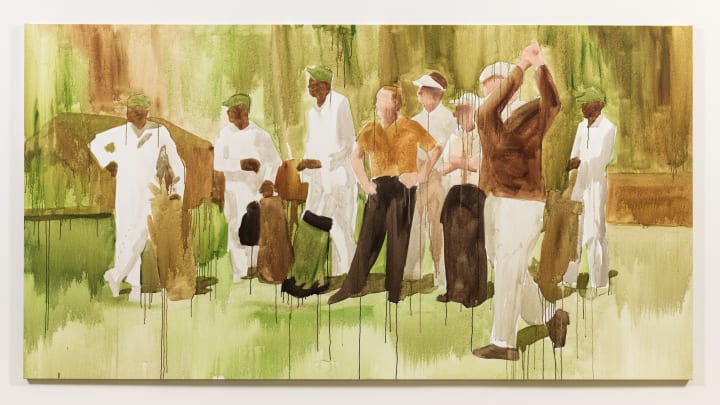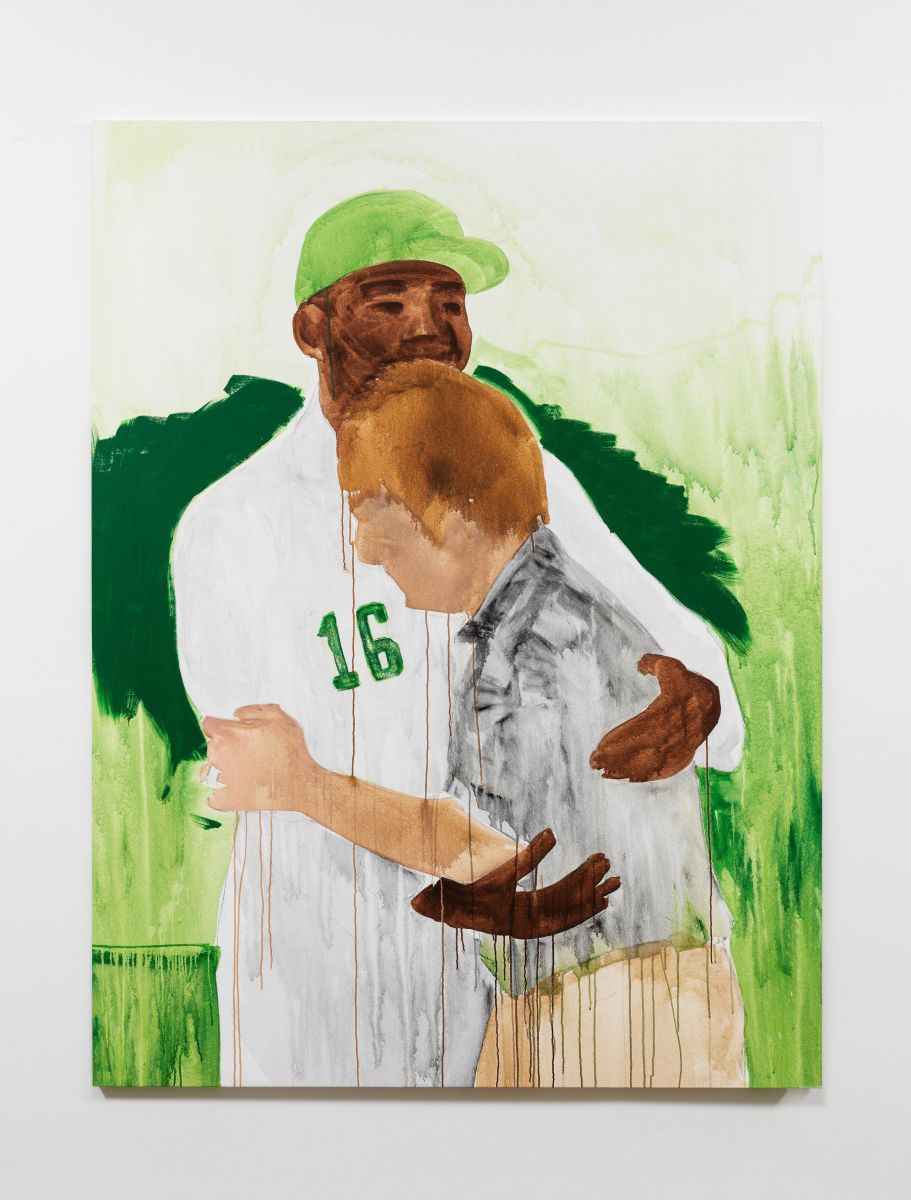Henry Taylor’s Paintings of Black Masters Caddies Chronicle a Complicated History

The topic of racial justice in America today has reached a ubiquitous and fevered pitch that demands the attention, understanding, and movement toward progress of all of this country’s citizens.
Los Angeles-based artist Henry Taylor, whose work has been exhibited widely and is housed in the collections of many of America’s major art museums, tackles this topic with a critical even-handedness in the worlds of golf and horse racing in a fascinating exhibition titled “Henry Taylor. Disappeared, but a Tiger Showed Up, Later," which is currently being shown at the Hauser & Wirth Southampton gallery in New York through Aug. 1. Taylor’s mostly large acrylic paintings focus on the Masters Tournament’s now-extinct tradition of only allowing Black caddies to work the event each April.
Indeed, all must cringe when reminded that Augusta National Golf Club and Masters co-founder Clifford Roberts once said, “As long as I’m alive, golfers will be white and caddies will be Black.”
In 1982, the club revoked that requirement and allowed players to use the caddies of their choice, many of whom the pros employed for the entire season. While this represented progress of sorts, it also meant that the presence of Black men in golf would most definitely decline.
Taylor, 63, is an inventive and intuitive portraitist. His figurative work reflects in breathtaking ways the art of Picasso, Matisse, David Hockney, Romare Bearden, Jacob Lawrence and the more contemporary so-called graffiti artists such as Jean-Michel Basquiat.
“While some would describe Henry Taylor’s style as untrained, primitive or naïve, he’s had solid training as a painter, having studied at the California Institute of the Arts near L.A.,” said Joseph Slusky, a Berkeley-based sculptor and retired professor from the University of California-Berkeley. “His subjects come from all walks of life, and whether it’s a celebrity, an athlete or a homeless person living on the street near his L.A. studio, his portraits go deeply into people’s souls and psyches. In other words, he’s very real.”
Taylor took the images for this show’s work from archival photographs, several of which he glosses with sepia-toned brush strokes and drips of paint, which give the work the illusory patina of age. One piece set during the 1960 Masters is titled, “We Was Watching Him, but They Really Was Watching Us.” In it, many golf fans will easily identify Ben Hogan by the iconic finish of his swing, and his onlooking playing partner Arnold Palmer by his broad shoulders and the insouciant manner in which he rests his hands on his hips. Behind them stand a row of Black caddies, clad in their Masters-required white boiler suits and green caps, carefully supporting their players’ bags.
It is a graceful and beautiful painting of a tee-box scene that at most any other tournament, with most any other two golfers might seem both common and unremarkable. However, in the fertile imagination of Taylor, the famous golfers and the anonymous caddies become metaphorically democratized, as they all play an equal part in the painting’s overall rhythmic geometrical composition, and, by extension, the tournament itself as well as life outside of the ropes.
In the exhibition’s press release, Taylor discusses what motivated him to create this body of work, most of which he completed in 2018. “I remember when there were a lot of Black caddies,” Taylor said. “My mom cleaned houses for a living and now the maids are Hispanic. Different people disappear. The caddies disappeared. That was enough reason for me to paint them.”

Taylor captures another classic Masters moment, entitled one that is emblazoned in the memories of many golf fans. After Ben Crenshaw made the final putt to win the 1995 Masters, he dropped his putter, bowed his head into his hands and then sobbed into the embracing arms of his caddie, Carl Jackson, who also caddied for Crenshaw’s first green jacket-win in 1984. In "Hush Now ... You Won ... " there is a lot to appreciate how Taylor has immortalized this already well-known tableau, as the emotionally spent and boyish-looking Crenshaw finds support and comfort in Jackson’s big-brotherly, stable and tender embrace.
Jackson, now 74, caddied in every Masters between 1961 and 2015 save one. At 65, Jackson was asked what advice he would give to a young Black man interested in pursuing golf. “It would be my suggestion,” he said, “to try to be the player.”
Another untitled painting presents the unmistakable image of the late Calvin Peete, a 12-time PGA Tour winner, at the top of his backswing. Taylor, in interviews and lectures, often talks about his love for sports, including the fact that his cousin, Don Buford, played 10 years for Major League Baseball’s Chicago White Sox and Baltimore Orioles, and that as a kid he dreamed of becoming a professional athlete. Students of the golf swing might marvel at the manner in which Taylor captured the angular gyrations of Peete’s unusual golf swing, replete with his shaft crossing the line at the top, his left arm bent and his right elbow flared akimbo.
The painting is set during the 1981 U.S. Open, a year before Peete would become just the second Black golfer — following Lee Elder who was the first in 1975 — to play in the Masters. Answering a question about how the Masters’ caddie tradition made him feel, the ever-direct Peete replied, “to ask a Black man what he feels about the traditions of the Masters is like asking him how he feels about his forefathers who were slaves.”
The exhibition also contains several of Taylor’s Black jockey paintings, which, again, bear witness to a sad chapter in America’s sporting life and history. Black jockeys once dominated professional horse racing. In the first Kentucky Derby, held in 1875, 13 of the 15 jockeys riding were Black. However, the success of these riders up through the 1920s stemmed a backlash in the Jim Crow South, and soon after they were totally barred from participating in professional horse racing altogether.
Alitash Kebede, a Los Angeles-based private art dealer who specializes in work made by African Americans said that Taylor’s paintings in this collection bring to mind those made by the great African American artist Jacob Lawrence, especially his masterpiece of social realism, “The Great Migration.” Completed in 1941, this internationally revered work chronicles the migration of over a million African Americans from the South to the Industrial North between 1910 and the 1920s.
“One of the things I love and admire most about Henry Taylor’s work,” Kebede said, “is that, in addition to his tremendous talent and technical skills and the beauty of the paintings themselves, every time I look at it I always learn something new, either about human nature, or history, and, more often than not, about both.”
Yet it may be the sphynx-like title of this show itself, “Henry Taylor. Disappeared, but a Tiger Showed Up, Later," that best weaves together Taylor’s themes of sports and race in American history and society. Tiger Woods never appears in any of the show’s paintings, but his presence has far from disappeared. Rather, he looms, even lurks suggestively in what’s referred to as the paintings’ negative spaces and thus becomes a significant and poignant player in the overall thematic message of the show by virtue of his absence.
Is Taylor calling Tiger Woods out as a Black man to do more to heal the racial tensions that plague his country and threaten its very core principles of “liberty and justice for all”? Or is the artist celebrating the fact that since Woods’ bursting onto the professional golf scene in 1996, the game has seen the proliferation of programs, such The First Tee and the development of more golf teams at Historically Black Colleges and Universities, including Paine College, which Augusta National Golf Club supported with endowed scholarships named for Elder and funded the creation of a women’s golf program. Also, no one can deny that Woods’ phenomenal success and broad-based, inclusive and enduring (though at times challenged) popularity, has led to the flowering of legions of Black golfers and golf fans.
Among the many and often paradoxical challenges, the pleasures of art lie in the fact that at its core art asks more questions than it promises to answer. Thankfully, paintings like Henry Taylor’s in this exhibition encourage us to look inside ourselves and to work outwardly to make this world a better place for all.
